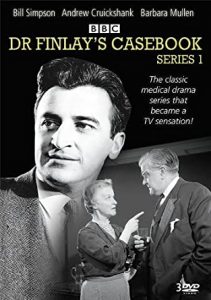AJ Cronin was one of those authors who was dearly loved by millions of readers in the 1950s when I was growing up. People like my mother had read his books – along with those of Daphne du Maurier, Naomi Jacobs, Hammond Innes, Neville Shute and many others before the war when she was growing up herself. These authors were still active in the post-war period and tens of millions of library users awaited their new books eagerly.
My snobbish, narrow minded grammar school English teachers condemned these writers as “middlebrow”, by the way, so it was best not to mention them in class. Were we really supposed to read Chaucer, Swift and Conrad in bed or on the bus when we were 14? I was, and am, a voracious and eclectic reader but not because of anything I was told in school.
Anyway AJ Cronin and his ilk were ubiquitous in our household and I read most of his best known works – Hatter’s Castle and The Citadel for example – in my teens. But I don’t think I ever read any Doctor Finlay stories partly because Doctor Finlay’s Casebook arrived on TV in 1962 (and ran for eight series until 1971) memorably starring Bill Simpson, Andrew Cruikshank and Barbara Mullen. There were only three channels at the time so almost everyone watched it.

It’s a strange hotch-potch of a book to read now. It isn’t quite short stories and it isn’t quite a novel – it reads like notes for a TV series in places but Scottish physician Archibald Joseph Cronin (1916-1981) can’t have had that sort of foresight when he first wrote these stories for a Hearst magazine between 1935 and 1939. Later they were republished under various titles in book form including, eventually Doctor Finlay’s Casebook.
Finlay is a young, Glasgow trained doctor who becomes assistant to an older doctor in the fictional town of Levenford between the wars. Like Morse, he does without a given name. He’s decent, kind and medically on the ball. He isn’t above revenge, however, when someone upsets him. He’s sporty (if you count shooting hapless birds and tormenting fish), quite a whizz on the tennis court and keen on hill walking. He would dearly like to marry and has several romantic encounters none of which ends happily. During the course of the book we meet his patients, the residents of the town and get a pretty convincing picture of what it would have like to practise medicine in Scotland before the genesis of the NHS. Of course, Cronin was inspired by his own experiences.

AJ Cronin
Trying to read Doctor Finlay’s Casebook straight through is not quite satisfactory because the episodic format means that many things go unexplained. Some of the stories are self-contained. Others run on. It’s not consistent either. One minute he’s practising in Levenford and the next the whole practice seems to have moved to Tannochbrae. Finlay drives a gig out to see patients until, without explanation, he’s doing his rounds by car. Doctor Cameron is a wise, benign elder statesman with a huge amount of experience until he suddenly morphs into a lazy hypochondriac. The angelic Alice, a nurse, helps Finlay to run a convalescent home for children and seems to be the epitome of virtue until, without warning, she becomes a sexually exploitative femme fatale. Janet, the stalwart housekeeper, is grittily sensible until she gets cross with her two doctors and the worm turns – which seems unlikely.
The other thing which really took me aback was what an age of innocence this was. Finlay treats the children he looks after alone and in a very “hands on” way and at one point falls in love with a girl who has only just left school. It makes a 2023 reader, living in a world of child protection and DBS clearance, blink and wince a bit.
On balance – and very unusually for me – I think Doctor Finlay’s Casebook makes better drama than it does reading material. Maybe that’s why Cronin, by then in his late forties, was involved in the early instalments of the BBC series. It’s also why, I suppose, that it was serialised on radio (with the original TV cast) from 1970 to 1978. An ITV series with David Rintoul as Finlay, began in 1993, took the narrative into the 1940s and ran for four series. There were also dramatisations in the early 2000s. It clearly had/has masses of dramatic potential.
Next week on Susan’s Bookshelves: Cracking Humpty Dumpty by Tim Devlin